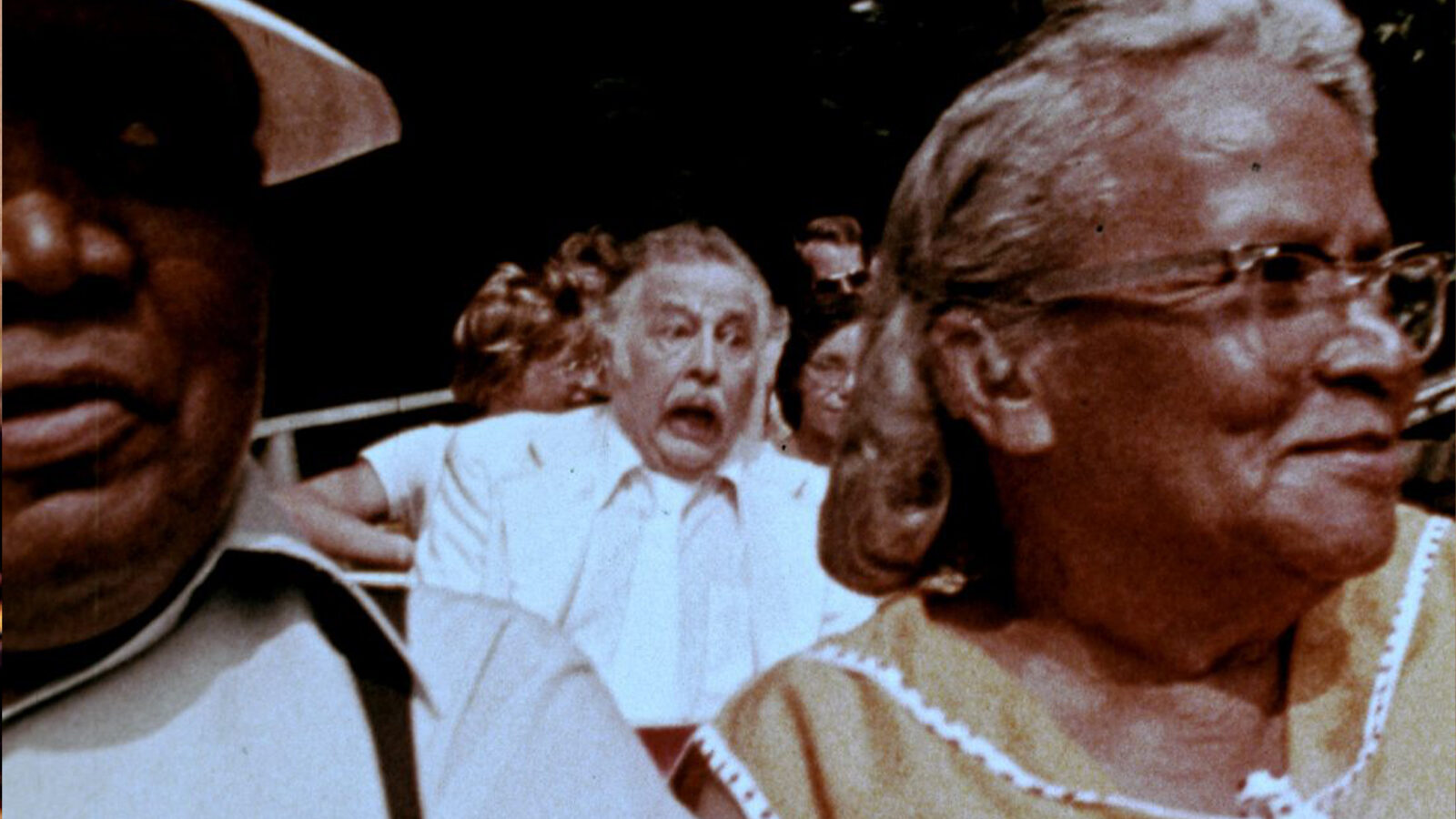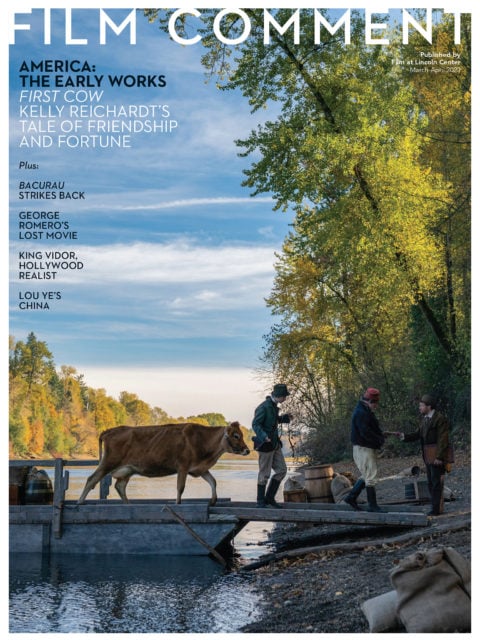By Maitland McDonagh in the March-April 2020 Issue

Step Right Up!
George Romero’s empathetic The Amusement Park confronts the horrors of the world through the eyes of the elderly
There’s no shortage of movies sold on the premise that viewers want to have the bejesus scared out of them. George Romero’s Night of the Living Dead (1968) and ensuing zombie cycle are classic examples. Romero’s The Amusement Park—completed in 1973, and recently rediscovered, restored, and screened at the Museum of Modern Art—is another one. Which is quite an accomplishment for an hour-long public service film about being nice to the elderly. Commissioned by the Lutheran Service Society of Western Pennsylvania and the Pitcairn-Crabbe Foundation (a charitable organization dedicated to supporting religious education and community-oriented projects), it was never released, reportedly because the producers were horrified by the results.

From the March-April 2020 Issue
Also in this issue
The backers might have been swayed by the appeal of using a local filmmaker. Though born and raised in the Bronx, Romero had moved to Pittsburgh to attend Carnegie Mellon University and liked it enough to stay. He founded his first production company, The Latent Image, in 1962 to make commercials and shorts, and built up a core group of local actors and crew members to whom he regularly turned. But they probably missed the memo that the genial filmmaker’s first feature helped fuel the fires of national breast-beating about movies that go too far. (Roger Ebert’s widely syndicated 1969 review of Night of the Living Dead was primarily about seeing it at a matinee, where it left a full house of unaccompanied children traumatized “with tears in their eyes.”) Perhaps the producers just liked the young man who’d chosen to put down roots in his adopted home rather than decamp to godless Hollywood.
With The Amusement Park, just a few years later, Romero delivered a movie that’s both grimly entertaining and impressively on message. That message is summarized in its preface: older Americans are becoming increasingly marginalized, made to feel useless, a burden to their children and society at large. That introduction is delivered by a neatly dressed older gentleman, actor Lincoln Maazel (father of acclaimed classical conductor Lorin Maazel), who has a bit of the older Orson Welles about him. As the film opens, Maazel stands on a path in West View Park, an amusement venue outside Pittsburgh. The setting is gloomy—the sky grey, the ground puddled. Maazel’s raincoat is not entirely a fashion statement. “On my next birthday, I will be 71 years of age,” he says, smoothly segueing into the observation that he’s been fortunate to have the luxury of working in a profession he loves and making a living. Indeed, though he appeared in only one other film—Romero’s Martin (1977)—and made a single television appearance, Maazel worked steadily in theater and nightclubs starting in the 1920s; he died at 106.
In this introduction, Maazel credits the owners of West View Park for offering the location free of charge, and the poignantly thanks many older people who worked without pay as actors/extras: “For some of the elderly players, [this was] the only enjoyable time they have had in recent years.” You need a heart of stone not to feel that one, and it’s the setup for Maazel’s parting shot: “Remember as you watch the film: one day, you will be old.” It’s hard not to hear an echo of the inscription in Rome’s beautifully bizarre Capuchin Crypt: “What you are now, we used to be; what we are now, you will be.”
What follows is a curious, existential setup: two men, both played by Maazel and dressed in white suits and shoes, meet in a stark, white room that easily could have been the stage set for a production of Sartre’s No Exit. One Maazel is dapper and confident. The other—bloodied and battered—warns against leaving the white room, which opens onto the amusement park via a freestanding portal door that no one outside seems to notice. “You won’t like it… there’s nothing outside.” Nothing good, anyway: what awaits the affable gentleman is a brutal education, conferred through an extended, picaresque series of encounters amid the hustle and bustle and run-down environs of the amusement park.
It’s not a fun visit. Maazel the innocent is denounced as a molester when he tries to share a snack with some children; bullied by bikers for being in their way (a foreshadowing, perhaps, of the bikers in Dawn of the Dead, who have no use for idiots trying to maintain the values of a world that existed before zombies ate up its niceties); castigated by younger people who demand to know why he doesn’t watch where he’s going, when they’re the ones barreling along like blinkered horses under the whip. He’s even ignored by police when he tries to give a statement about a minor accident on a car ride, caused by an arrogant young man who vehemently insists that the fault lies with a blameless older woman. “If there’s anything stupider than a woman driver it’s an old woman driver,” the offender sneers. “Everybody over 65 should be made to ride the bus.”
In keeping with Romero’s pragmatic nonfiction roots, The Amusement Park is shot matter-of-factly but with touches of efficient flair by frequent collaborator Bill Hinzman (Night of the Living Dead’s iconic cemetery zombie): POV shots from a roller-coaster car, tight medium shots that reduce carefree young parkgoers to jostling limbs and headless torsos, a glimpse of a man in a monster mask tucked in the background of a ride. Much of the film is shot outdoors in what looks like natural light; only the portal door that connects the white room to the amusement park and a scene involving a fortune-teller appear to use special effects. It’s not quite guerrilla filmmaking—Romero and his crew had the cooperation of West View Park’s management and some scenes were clearly filmed during off-hours—but it’s a triumph of determination, on-the-ground adaptability, and commitment to getting the job done and done well.
The Amusement Park is also kin to a book, Flesh, Metal & Glass—the vintage driver’s-education screed from 1974 heavy on photographs of dead people who didn’t bother to put on their seat belts and came to gruesome ends. Romero’s film is both more artful and less instructive—contrary to what generations of motorists seem to think, it’s not all that hard to clean up your driving act. But for people who see the elderly as a largely undifferentiated mass of problems, a huge shift in perspective is required, and attitude adjustment requires internal motivation. In fact, seeing them at all is an issue: the crowd of young people with balloons and snacks ebbs and flows around the older people, with no one noticing Maazel, the white woman with a cane, or the senior in a wheelchair. They’re invisible, except to the fellow buying their belongings so they will have ticket fare for the park’s attractions—and he clearly delights in offering them far less than their possessions (watches, jewelry, clocks) are worth.
Part of what makes The Amusement Park so affecting is the fact that in its compassion for the elderly, it’s still swimming against the current today. Mainstream movies are on notice about glamorizing or endorsing casual racism, abuse of women and girls, homophobia, and drunk/drugged driving. But making fun of clueless old people remains a standard comedy trope, and excluding the elderly is par for the course (except for hip aunties and wise grandpas who prop up young characters confused about life and romance). Yes, of course you love your grandparents, but they’re still old and (we assume) they either don’t understand or don’t much care for many of the ways in which the world has changed since they were in the prime of their lives, and they don’t hesitate to tell you so. The biting casualness with which a ride operator humiliates the smartly dressed man who failed a vision test that his wife passed is excruciating.
The Amusement Park is sharp social commentary rooted in brutal reality, a clear cousin to Romero’s Living Dead movies despite the fact that it was a work-for-hire project. The horror auteur’s zombie films are strikingly amoral and nonjudgmental: nice young people die and no-nonsense old people live; opportunists thrive while less ruthless ones don’t. It’s not just a matter of who gets the rules of a scary new world and adapts; sometimes it’s sheer luck. The Amusement Park’s introduction is a plea for understanding and support for the elderly, but its nightmarish narrative suggests that consciously or not, Romero was working out the moral parameters of the grim realm of zombies that became his legacy.
There’s no bright future on the horizon of this film or the Living Dead series—just a nastier, shorter, and more brutish version of the one with which we’re all familiar. Sleep on that, and hope for sweet dreams.
Maitland McDonagh is the author of four books, including Broken Mirrors/Broken Minds: The Dark Dreams of Dario Argento.







